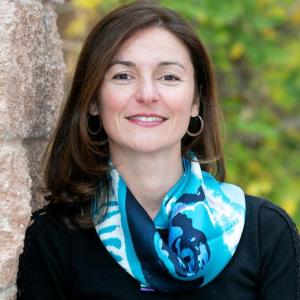Georgia Tech Researcher Receives $2.9M Grant to Develop Ingestible Probes for Breath-Based Cancer Detection
Jun 16, 2025 —

As the second-leading cause of cancer death in the U.S., colorectal cancer is rising in the number of cases in younger adults. To combat this and offer a less-invasive alternative to a colonoscopy, Wallace H. Coulter Department of Biomedical Engineering Assistant Professor Leslie Chan and her lab has been awarded a grant to develop an innovative diagnostic to detect colorectal cancer through a simple breath test. Read more.
Unveiling the Human Stories Behind Brain Implants
Jun 11, 2025 —

From clinical trial participant to BCI advocate, Ian Burkhart shares his story at “Wired Lives,” organized by Georgia Tech’s Neuro Next Initiative. Photo: Chris McKenney
Electing to have invasive brain surgery isn’t something most people have done. Ian Burkhart isn’t most people.
“When I finished rehabilitation, my doctors and therapist and, most importantly, the insurance company said, ‘For someone with your condition, we feel like you've made all the improvement that you will, have a nice life,’” said Burkhart, who was left with limited feeling and mobility below the neck after a 2010 diving accident injured his spinal cord. “That didn't sit well with me.”
Hoping even a fraction of hand mobility would increase his independence, Burkhart turned to a clinical research trial on a brain-computer interface (BCI) designed to detect movement signals in the brain and send them to a computer to stimulate the arm muscles, bypassing the spinal cord in the hopes of restoring movement.
“I had had four and a half years of never thinking my hand was going to move again,” he recalled. When testing to see if he qualified for the study, researchers stimulated his hand muscles. “I saw my hand move, and that was all I needed to know — I was ready to risk it all for something that may or may not work.”
Burkhart’s story is one of many that reveal the deeply personal side of neurotechnology research. Centering lived experiences like his is central to the mission of the Institute for Neuroscience, Neurotechnology, and Society (INNS), a new Interdisciplinary Research Institute launching this July at Georgia Tech.
“If we want to build neurotechnology that truly serves people, their voices should be part of the scientific process from the very beginning,” said Chris Rozell, a professor in the School of Electrical and Computer Engineering and one of the many researchers at Georgia Tech working to understand and advance BCIs. “Hearing from individuals who live with these devices helps guide more ethical, inclusive, and effective research. The entire field benefits from inclusive conversations like these.”
Life With a Brain Implant
Burkhart and three others recently shared their stories live on the Ferst Center stage at “Wired Lives: Personal Stories of Brain-Computer Interfaces, an event organized by Georgia Tech’s Neuro Next Initiative. Their stories gave over 200 attendees a rare, honest glimpse into the realities of neurological conditions and the path to brain-computer interface research.
“I was at a crossroads in my life at 47 years old,” said Brandan Mehaffie, who told his story of living with early-onset Parkinson’s disease. “I was trying to figure out, do I continue with the status quo and watch my career dwindle into nothing? Watch my life with my family, my kids, not being able to go on hikes or family vacations?”
Mehaffie eventually qualified for deep brain stimulation (DBS) treatment, a procedure where a pacemaker-like device is implanted into the brain to provide electrical stimulation. “It changed my life for the better in ways that I can't even tell you.”
When former U.S. Air Force Sgt. Jennifer Walden’s doctor told her about a clinical trial testing DBS as an epilepsy treatment, she jumped at the chance. “The 48 hours after those seizures are 48 hours where you don't want to live anymore.” Walden explained that her response to medication had dwindled after years of traditional treatment, increasing the frequency and severity of her seizures. “I feared suicide. It's something I didn't want to do, but if something happened in those 48 hours to end my life, I didn't care,” she said.
“I am now probably 99% seizure-free,” she beamed as she recalled her response to DBS on stage. “I don't know how I got so lucky in life, but I don't take it for granted.”
Common themes in their stories were resilience, hope, and a deep desire to give back.
“When I joined the study, it had no physical benefit to me, but that's not why I joined it,” said Scott Imbrie, who experienced a major spinal cord injury and participates in a clinical BCI study at the University of Chicago. “I decided to have invasive brain surgery and have electrodes implanted on my brain to help other people.”
A New Approach to Interdisciplinary Research
Timed alongside the InterfaceNeuro conference at Georgia Tech, the gathering offered a rare opportunity for scientists, engineers, and clinicians to engage directly with the lived experiences of individuals using brain-computer interfaces — a perspective often missing from traditional research settings.
“It makes you think about how we ethically conduct research and how we recruit and interface with patients,” said Eric Cole, a postdoctoral researcher at Emory University, who was reminded that many patients participating in BCI research have been on a long, difficult journey before interacting with researchers. “We should remember to take their experiences seriously and respect them. They're giving up something for research — that part we should always remember.”
“Wired Lives” was one in a series of events highlighting the lived experience of individuals with neurological conditions organized by the Neuro Next Initiative, which has served as the precursor to INNS.
“A core mission of INNS is to consider how neuroscience and neurotechnology impact people’s lives,” said Jennifer Singh, associate professor in the School of History and Sociology, a member of NNI’s executive committee, and a co-organizer of the event. “Their stories matter when it comes to the types of science and technology we pursue and how they benefit the human condition. Many scientists and engineers may never encounter people living with neurological conditions outside of events like this. That will be a priority for INNS — to bring the expertise of lived experiences to the research process.”
Ian Burkhart’s lived experience reminded the audience that not every clinical trial has a happy ending. His BCI was ultimately removed after seven years as research funding ran short, taking his newly improved hand mobility with it. Despite this, Burkhart remained positive.
“I'm so glad I was able to take that risk and have that voluntary brain surgery and participate in this type of research because it's defined my life.” Burkhart went on to found the BCI Pioneers Coalition and his own nonprofit because of his research participation. “It gave me a lot of hope for the future, and a lot of hope that these types of devices are going to be able to help people and improve their quality of life.”
This event was produced in partnership with The Story Collider and made possible through support from Blackrock Neurotech and Medtronic.
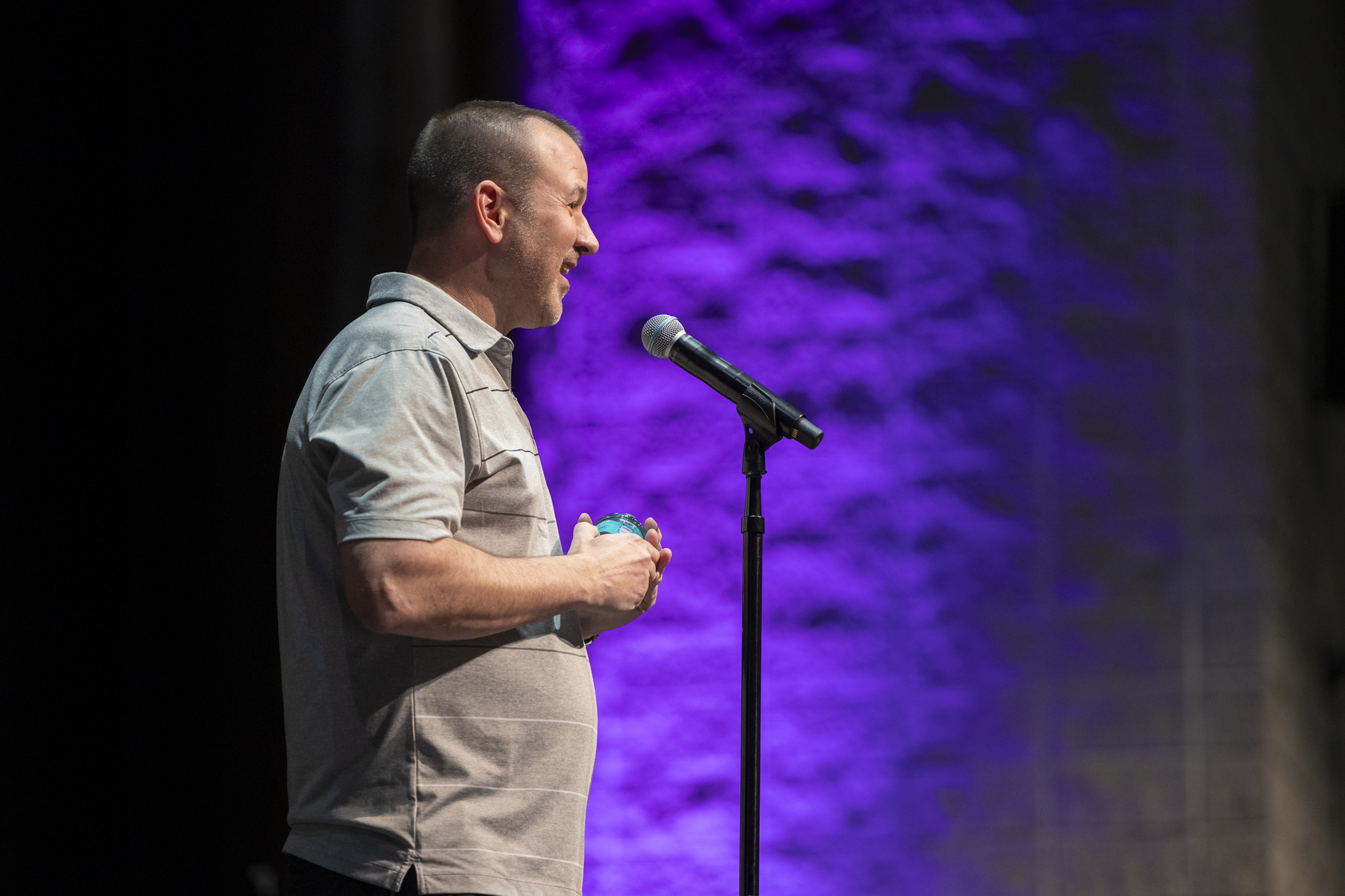
Brandan Mehaffie shares how deep brain stimulation transformed his life after an early-onset Parkinson’s diagnosis. Photo: Chris McKenney

Jennifer Walden reflects on the emotional and physical challenges of epilepsy — and the relief that came with a breakthrough treatment. Photo: Chris McKenney
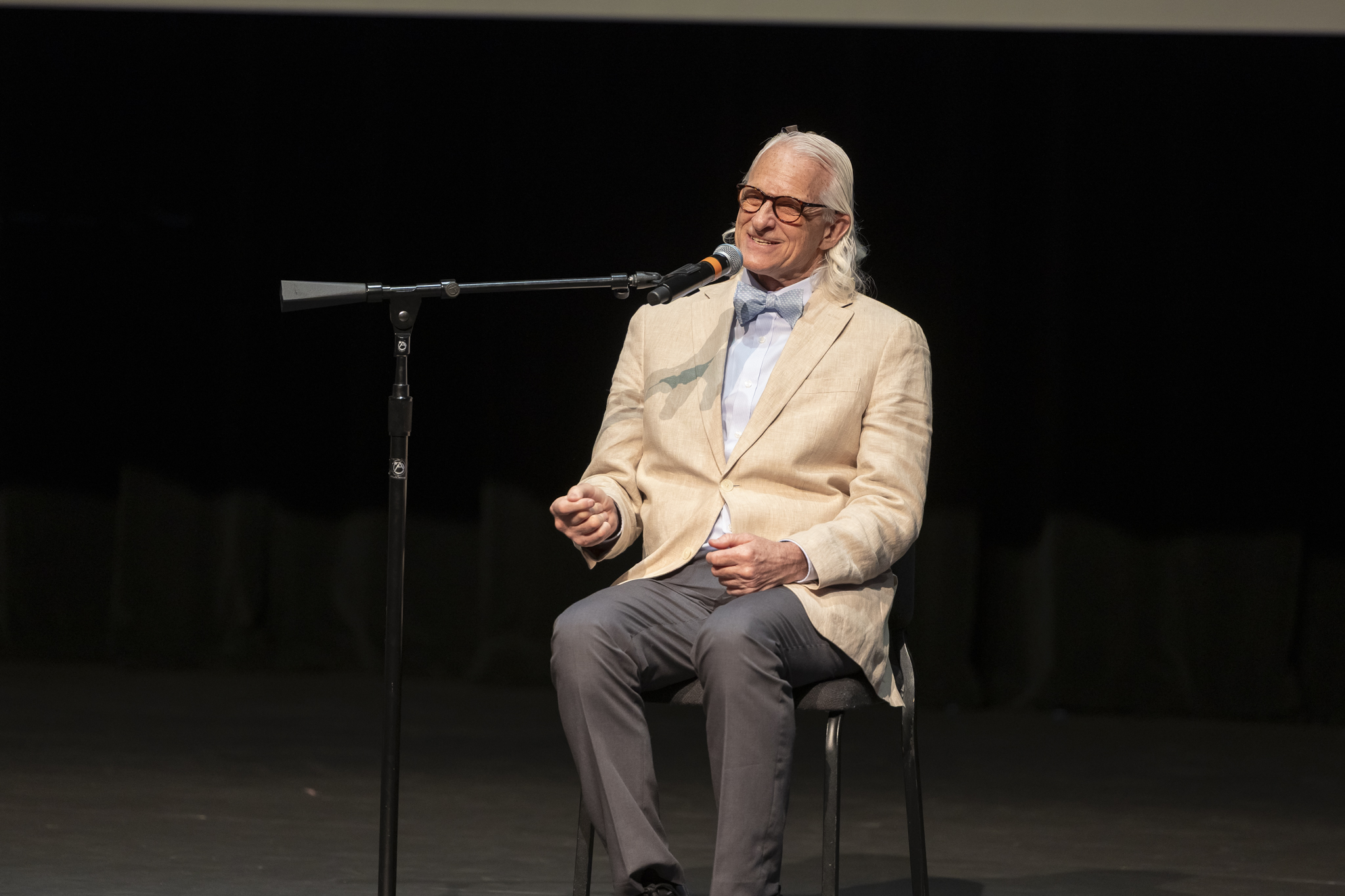
Scott Imbrie shares his decision to undergo brain surgery — not for personal benefit, but to advance research that could help others. Photo: Chris McKenney
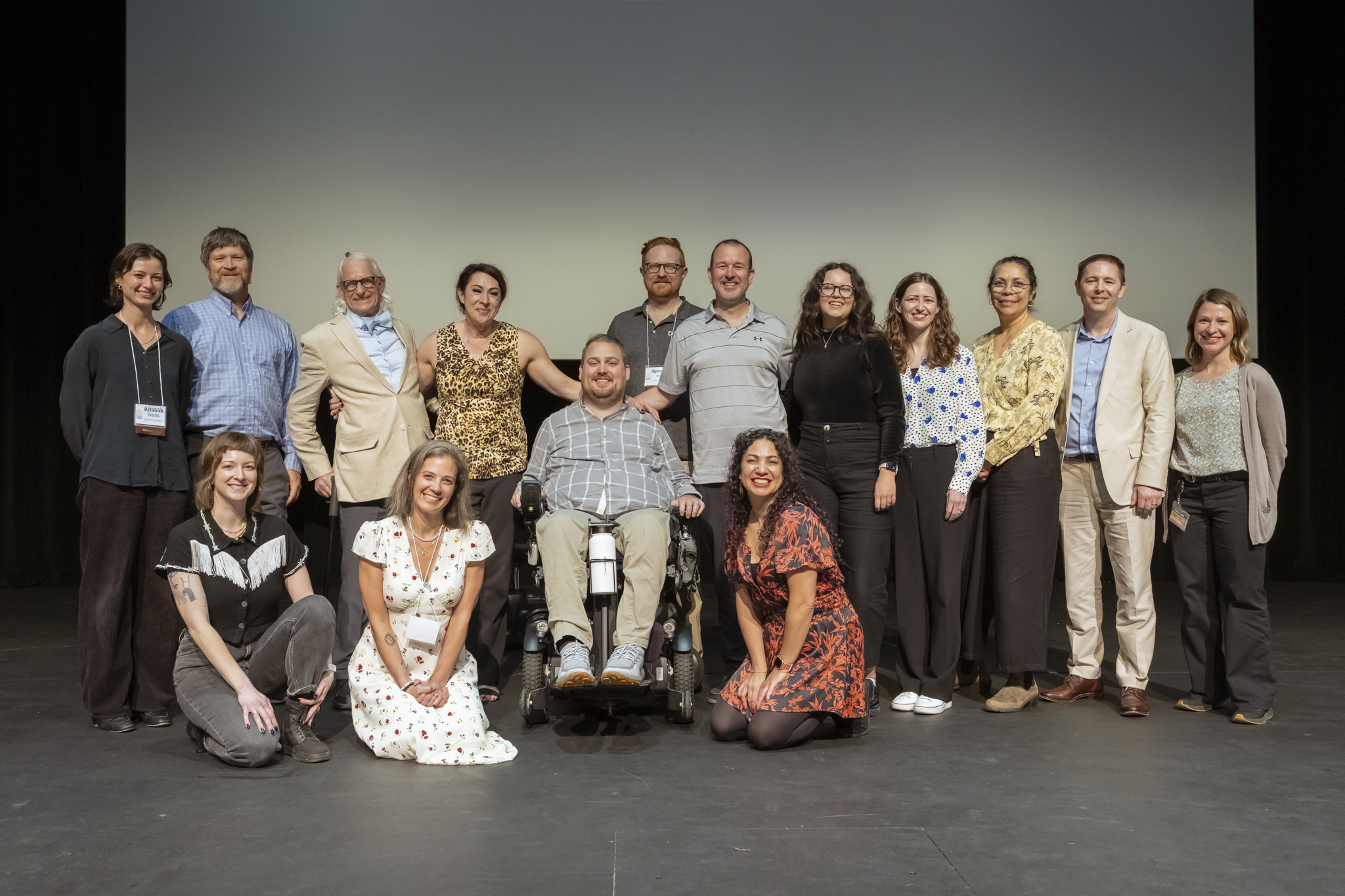
Storytellers, event organizers, and sponsor representatives at "Wired Lives."
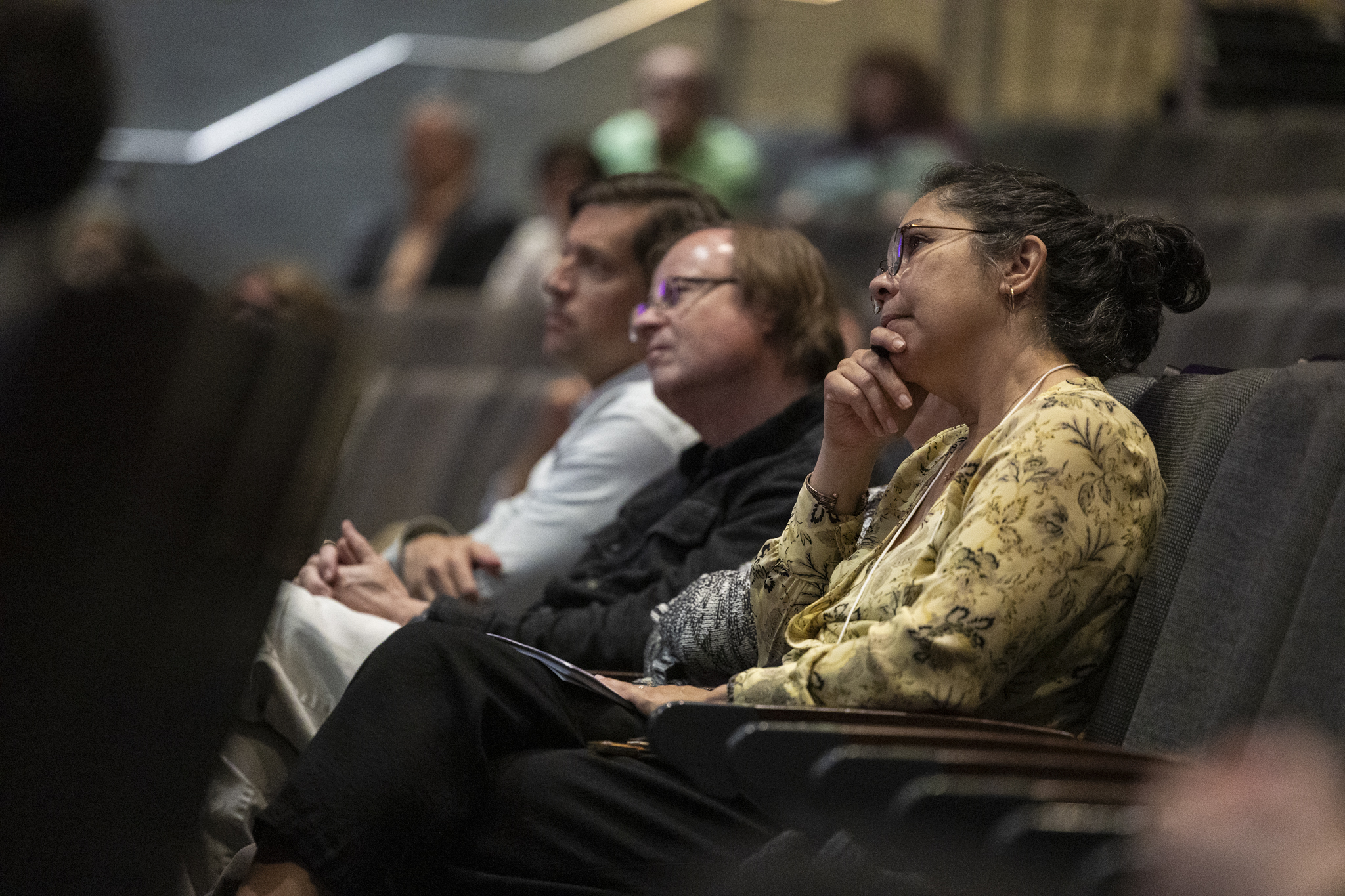
Researchers, students, and community members came together to explore the lived experiences behind cutting-edge neurotechnology. Photo: Chris McKenney
Audra Davidson
Research Communications Program Manager
Neuro Next Initiative
Georgia Tech Team Takes Second Place at ICRA Robot Teleoperation Contest
Jun 11, 2025 —

An algorithmic breakthrough from School of Interactive Computing researchers that earned a Meta partnership drew more attention at the IEEE International Conference on Robotics and Automation (ICRA).
Meta announced in February its partnership with the labs of professors Danfei Xu and Judy Hoffman on a novel computer vision-based algorithm called EgoMimic. It enables robots to learn new skills by imitating human tasks from first-person video footage captured by Meta’s Aria smart glasses.
Xu’s Robot Learning and Reasoning Lab (RL2) displayed EgoMimic in action at ICRA May 19-23 at the World Congress Center in Atlanta.
Lawrence Zhu, Pranav Kuppili, and Patcharapong “Elmo” Aphiwetsa — students from Xu’s lab — used Egomimic to compete in a robot teleoperation contest at ICRA. The team finished second in the event titled What Bimanual Teleoperation and Learning from Demonstration Can Do Today, earning a $10,000 cash prize.
Teams were challenged to perform tasks by remotely controlling a robot gripper. The robot had to fold a tablecloth, open a vacuum-sealed container, place an object into the container, and then reseal it in succession without any errors.
Teams completed the tasks as many times as possible in 30 minutes, earning points for each successful attempt.
The competition also offered different challenge levels that increased the points awarded. Teams could directly operate the robot with a full workstation view and receive one point for each task completion. Or, as the RL2 team chose, teams could opt for the second challenge level.
The second level required an operator to control the task with no view of the workstation except for what was provided to through a video feed. The RL2 team completed the task seven times and received double points for the challenge level.
The third challenge level required teams to operate remotely from another location. At this level, teams could earn four times the number of points for each successful task completed. The fourth level challenged teams to deploy an algorithm for task performance and awarded eight points for each completion.
Using two of Meta’s Quest wireless controllers, Zhu controlled the robot under the direction of Aphiwetsa, while Kuppili monitored the coding from his laptop.
“It’s physically difficult to teleoperate for half an hour,” Zhu said. “My hands were shaking from holding the controllers in the air for that long.”
Being in constant communication with Aphiwetsa helped him stay focused throughout the contest.
“I helped him strategize the teleoperation and noticed he could skip some of the steps in the folding,” Aphiwetsa said. “There were many ways to do it, so I just told him what he could fix and how to do it faster.”
Zhu said he and his team had intended to tackle the fourth challenge level with the EgoMimic algorithm. However, due to unexpected time constraints, they decided to switch to the second level the day before the competition due to unexpected time constraints.
“I think we realized the day before the competition training the robot on our model would take a huge amount of time,” Zhu said. “We decided to go for the teleoperation and started practicing.”
He said the team wants to tackle the highest challenge level and use a training model for next year’s ICRA competition in Vienna, Austria.
ICRA is the world’s largest robotics conference, and Atlanta hosted the event for the third time in its history, drawing a record-breaking attendance of over 7,000.
Georgia Tech Hosts Kickoff for Space-Bound Black Hole Imaging Mission
Jun 10, 2025 —

The kickoff meeting marked the first time that a large group of team members came together in person. Team members shared what they will bring to the mission and spent time refining the goals and requirements of the mission.
A new mission strives to take black hole imaging to space. Scientists from the Georgia Institute of Technology, the Georgia Tech Research Institute (GTRI), the National Aeronautics and Space Administration (NASA), and 12 universities from around the world recently convened for a three-day workshop to plan the launch of the Space-based Precision Millimeter Interferometry Telescope (SPRITE) project. The proposed NASA Medium-Class Explorer mission aims to revolutionize the understanding of black holes through space-based imaging.
From Earth to orbit: The next step
SPRITE builds on the groundbreaking achievements of the Event Horizon Telescope (EHT), a network of ground-based telescopes able to synchronize observations from around the globe. EHT is most well-known for capturing the first images of black holes, M87* and Sagittarius A*.
“We’ve done what we can from the ground; we’ve run out of Earth,” says Professor and Chair of the School of Physics Feryal Özel, SPRITE’s principal investigator and a well-known astrophysicist instrumental in EHT’s success and development. “SPRITE will send two telescopes into orbit – achieving better imaging than a dozen telescopes on the ground.”
By sending the telescopes into space, the mission will be able to overcome the limitations of Earth’s atmosphere, which blocks certain wavelengths of light and produces turbulence that can degrade image quality. Unlike Earth-based telescopes, which rely on the planet’s rotation to change viewing angles, SPRITE’s telescopes will rotate independently across the vastness of space with data continuously transmitted from the satellites to ground stations.
“I like to think of it as an MRI machine rotating around a patient,” explains Özel. “In space, our telescopes can perform this orbital dance from great distances – giving us multiple perspectives of a black hole and allowing us to build a much more complete image.”
Mission goals
SPRITE’s objectives are ambitious and far-reaching, specifically to:
- Create more images of previously unseen black holes at resolutions better than M87* and Sagittarius A*;
- Confirm the presence of binary black holes through visual imagery; and
- Study the hot gas dynamics around black holes.
This class of mission requires a three-year operational lifetime to achieve its main science goals – although planners estimate the project will be able to operate considerably longer.
Preparing for launch
SPRITE is being organized to reflect Georgia Tech’s commitment to advancing space science through interdisciplinary collaboration and innovation, and will work closely with the Institute’s new Space Research Initiative. Locating SPRITE at Georgia Tech allows the mission to benefit from the knowledge of leading experts from the Colleges of Sciences, Engineering, and Computing; and GTRI.
The recent kickoff meeting marked SPRITE’s first large-scale gathering of contributors from around the world.
“We had smaller meetings before, but this was the first time the full team came together to share expertise and collaboratively shape the mission,” says Özel. “Most importantly, this meeting showed us that we have a strong scientific case for our mission and its design.”
Over the next two to three years, the team will work to validate key technologies and prepare a compelling proposal for NASA. If selected, SPRITE is expected to launch in the mid-2030s, marking the beginning of a new era in space imaging.
Laura S. Smith, writer
Find a Feline: A New App Helps Georgia Tech Track Its Campus Cats
Jun 09, 2025 —
Petunia, a campus cat who has now been adopted, in her GT home. [Photo by Allison Carter]
When visitors come to Georgia Tech, they can meet some of the top scientists in the world, the next generation of researchers — and a few dozen feral and stray cats. Everywhere from the eaves of Bobby Dodd Stadium to the bushes surrounding the School of Architecture buildings, more than 40 cats call campus home.
The cats love Georgia Tech — not just for the adoring students who try to sneak in pets between classes, but also because of GT Campus Cats. The registered student organization is led by undergraduates who feed, provide shelter, handle trap-neuter-return (TNR) services, facilitate fosters and finding forever homes, and provide veterinary care to members of the cat colony. Now their work is a lot easier, thanks to a new app.
Developed by computer science students in a capstone class, the app simplifies tracking the cats on campus. Anyone with a GT login can access the app, where they can see photos and bios of known cats, explore a map of sightings, and even add their own.
Building the Purrfect App
Caroline Hatcher began her term as GT Campus Cats president in November 2024. At the time, the organization relied on the website platform iNaturalist to follow the cats, but the system wasn’t very user-friendly. So, when a computer science (CS) capstone class asked the group if they could design an app for them, the group pounced on the offer.
“Our main concern was being able to use it on a phone because iNaturalist doesn’t work well on mobile,” said Hatcher, a fourth-year architecture student. “With the app, you can log in with the GT single sign-on, which makes it easier for students to use.”
Through virtual meetings over five months, organization members worked with the CS students to determine the app’s needed features. The team included computer science undergraduates Will Akins, Matthew Pendarvis, Dragos Lup, Robert Zhu, and Amulya Panakam.
Hatcher could tell it was more than just a final project for them.
“The computer science students were genuinely interested and came out to workdays with us when we built shelters or did TNR, so we could tell that they cared,” she said.
One of the biggest concerns was who could have access to the app. While GT Campus Cats has 250 members, with 80 assisting with TNR, shelter maintenance, and feeding the cats, up to 2,500 people are on the organization’s GroupMe text chat. As popular as the cats are, the group wants to ensure they stay safe, and they don’t want to encourage strays being left on campus. Consequently, the app has different permissions for different members. Anyone with a GT login can view which cats have been identified and report sightings. But only group members can see where the 14 campus feeding stations are.
Maintaining the Meow Map
For the CS students who created it, making the app was rewarding. Unexpectedly, half of them are allergic to cats but wanted to help the campus cats anyway.
“We wanted to build this because we knew it would have a tangible impact on the campus, like the GT scheduler, a tool to help people create their class schedules that students also developed,” explained Robert Zhu, who graduated this spring. “The chance to leave that kind of legacy is something we were very interested in.”
While the capstone project is over, use of the app is rapidly increasing. Hatcher is actively adding cat profiles to the map, and Zhu plans to refine the code this summer. He hopes the app will eventually be maintained by student nonprofit Bits of Good to ensure it keeps meeting the needs of GT Campus Cats — and, of course, the four-legged friends it serves.
Tess Malone, Senior Research Writer/Editor
tess.malone@gatech.edu
A New Metal Design for Solid-State Batteries
Jun 05, 2025 — Atlanta, GA

Sun Geun Yoon works in a glove box in McDowell’s laboratory at Georgia Tech. [Photo by Christopher McKenney]
Lithium-ion batteries power everything from electric cars to laptops to leaf blowers. Despite their widespread adoption, lithium-ion batteries carry limited amounts of energy, and rare overheating can lead to safety concerns. Consequently, for decades, researchers have sought a more reliable battery.
Solid-state batteries are less flammable and can hold more energy, but they often require intense pressure to function. This requirement has made them difficult to use in applications, but new research from Georgia Tech could change that.
The research group of Matthew McDowell, professor and Carter N. Paden Jr. Distinguished Chair in the George W. Woodruff School of Mechanical Engineering and the School of Materials Science and Engineering, has designed a new metal for solid-state batteries that enables operation at lower pressures. While lithium metal is often used in these batteries, McDowell’s group discovered that combining lithium with softer sodium metal results in improved performance and novel behavior.
McDowell and his collaborators presented their findings in the paper, “Interface Morphogenesis with a Deformable Secondary Phase in Solid-State Lithium Batteries,” published in Science on June 5.
Stackable Solution
Lithium-ion batteries have been the industry standard because they combine compact size, reliability, and longevity. However, they contain a liquid “electrolyte,” which helps lithium ions move in the battery but is also flammable. In solid-state batteries, this electrolyte is a solid material that is less flammable. The challenge is that when the battery is used, the lithium metal in the battery changes its shape, potentially losing contact with the solid electrolyte, which degrades performance. A common way to ensure the metal doesn’t lose contact is to apply high pressure to these batteries.
“A solid-state battery usually requires metal plates to apply this high pressure, and those plates can be bigger than the battery itself,” McDowell said. “This makes the battery too heavy and bulky to be effective.”
The researchers, led by Georgia Tech research scientist Sun Geun Yoon, sought a solution. The solid-state batteries would still require some pressure to function, but they found that by also using a softer metal, less pressure is required. The researchers decided to pair the commonly used lithium metal with a surprising element: sodium.
“Adding sodium metal is the breakthrough,” McDowell noted. “It seems counterintuitive because sodium is not active in the battery system, but it’s very soft, which helps improve the performance of the lithium.”
How soft can sodium be? In a controlled environment, a person could stick their gloved finger into sodium metal and leave an imprint.
From Biology to Battery
To understand the enhanced performance of their battery, the researchers borrowed a concept from biology called morphogenesis. This concept explains how tissues or other biological structures evolve based on local stimuli. Morphogenesis is rarely seen in materials science, but the researchers found that the combination of lithium and sodium behaves according to this concept.
McDowell’s research group has been working on applying morphogenesis to battery materials as part of a project funded by the Defense Advanced Research Projects Agency in collaboration with several other universities. Their battery is among the first viable demonstrations of this concept — effectively, the sodium deforms readily at the low pressures needed for solid-state batteries to function.
Battery Boon
The possibilities of a viable, smaller solid-state battery are vast. Imagine a phone battery that could last much longer or an electric vehicle that could drive 500 miles between charges. With this in mind, McDowell and his team have filed for a patent for this battery system.
While solid-state batteries still have some way to go before commercial use, results like these could mean that solid-state batteries can compete with lithium-ion. McDowell’s lab continues to experiment with other materials to further improve performance.
Funding from the Defense Advanced Research Projects Agency.
Tess Malone, Senior Research Writer/Editor
tess.malone@gatech.edu
Army Awards Tech-Led Project $20M to Develop Aluminum Manufacturing for Hydrogen Energy Production
Jun 05, 2025 — Atlanta, GA

Scientists at the Army Research Laboratory found that an aluminum-based powder prompts hydrogen to split from water. Now, a Georgia Tech-led partnership will carry that research forward. Credit: US Army
Aluminum scrap is one of the most common materials found on military bases and aircraft carriers worldwide. Now, the U.S. Army has tapped Georgia Tech to help turn that waste into power that can be generated off the grid and on demand.
The Army Research Office awarded Georgia Tech and its partners $20 million to develop scalable, efficient methods for transforming aluminum into hydrogen energy. The project could lead to a new, low-cost, clean, and efficient energy source powered by discarded materials.
Aaron Stebner, professor and Eugene C. Gwaltney Jr. Chair in Manufacturing in the George W. Woodruff School of Mechanical Engineering and professor in the School of Materials Science and Engineering, will oversee the multi-year effort at Georgia Tech together with Scott McWhorter, lead for Federal Initiatives at the Strategic Energy Institute.
In addition to several team members from Georgia Tech and the Georgia Tech Research Institute, the project includes researchers from Fort Valley State University, the 21st Century Partnership, MatSys, and Drexel University.
“Aluminum already reacts with water — even wastewater and floodwater — to create hydrogen gas, power, and thermal energy,” McWhorter said. “If aluminum can be efficiently upcycled into stored energy, it could be a game-changer.”
The team’s goal is to experiment with aluminum’s material properties so it can be inexpensively manufactured to create a highly effective reaction that produces low-cost, clean hydrogen.
“Having this ability would allow military bases to be less dependent on the use of a foreign country’s electrical grids,” said Stebner, who is also co-director of Georgia Artificial Intelligence in Manufacturing and faculty at the Georgia Tech Manufacturing Institute.
Manufacturing Aluminum
Several years ago, the Army Research Lab discovered and patented the basic technology for recycling aluminum to produce hydrogen gas. However, current manufacturing methods require too much energy for the amount of hydrogen energy produced.
To make the technology viable and effective, Stebner and his colleagues will research alternate manufacturing processes and then develop automated methods for safely producing and storing stable aluminum. They also plan to optimize these processes using digital twin technologies.
Currently, manufacturers use large machines to grind up and tumble the aluminum in very controlled environments, because stray aluminum powder can be explosive. These methods are very costly.
Stebner and the team are looking into small, modular technologies that could allow for convenient, onsite energy generation. According to Stebner, they are interested in determining how these smaller machines could be so efficient that they could be powered using solar panels.
Stebner envisions that a field of solar panels could power the aluminum-processing modules — the aluminum recycling could be done while the sun shines and produce power 24/7.
Sustainable Impact
Once they have developed the manufacturing techniques and processes, the team plans to test their efficacy by generating power for rural Georgia communities. Success here would prove the technology could be viable for military deployments and other off-grid scenarios.
“The Deep South — especially middle and southern Georgia, Alabama, Mississippi, and Louisiana — often has enormous energy disruptions during hurricanes or power outages due to flooding and severe rains,” Stebner said. “Manufacturers can be hesitant to build big plants there, because the grids aren’t as stable. This same technology that the Army plans to use for remote military bases could be a game-changer in rural Georgia.”
If power is unexpectedly cut in those areas, floodwater could then be used to make hydrogen gas. While hydrogen has not yet had its day in the sun, it has great potential as an alternative to fossil fuels, Stebner says.
“From a sustainability perspective, any time you can take something that’s already waste — like scrap aluminum and wastewater — and turn it into a high-value product that can be used to power communities, that is a huge win.”
Funding: Army Research Office
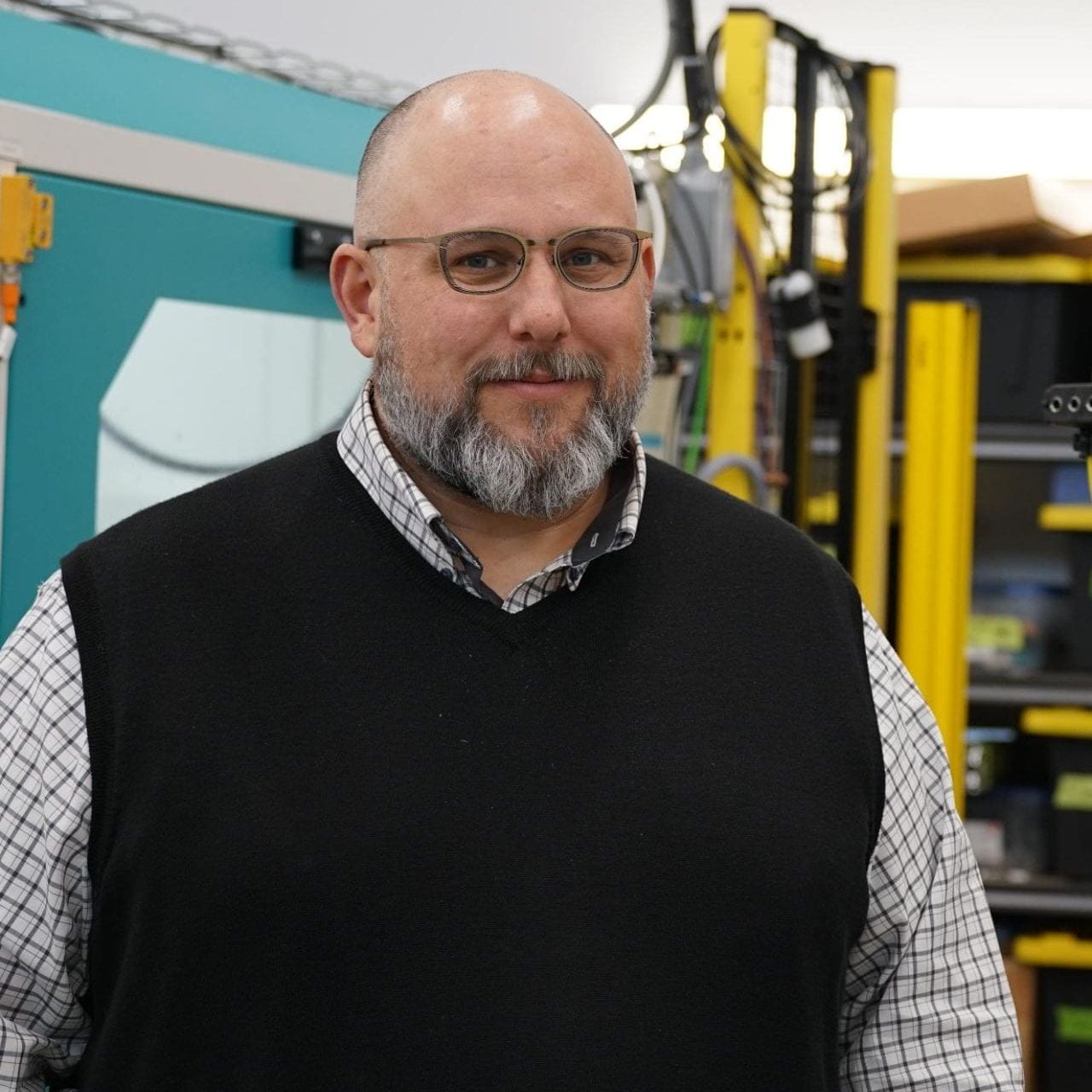
Aaron Stebner
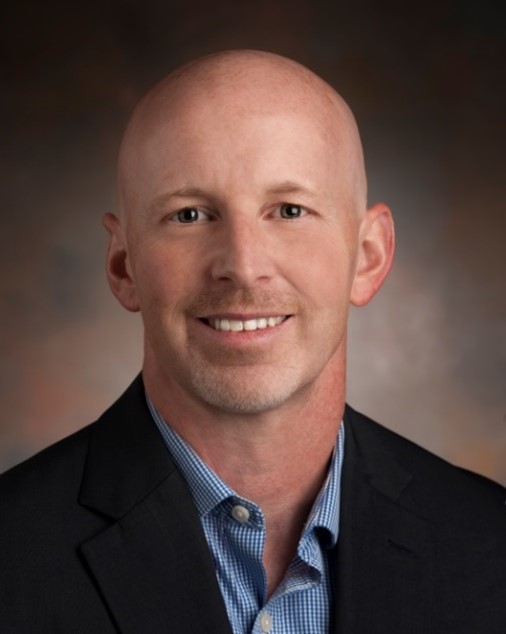
Scott McWhorter
Catherine Barzler, Senior Research Writer/Editor
Power Play: The Global Stakes Behind the Battery Boom
Jun 05, 2025 — Atlanta, GA
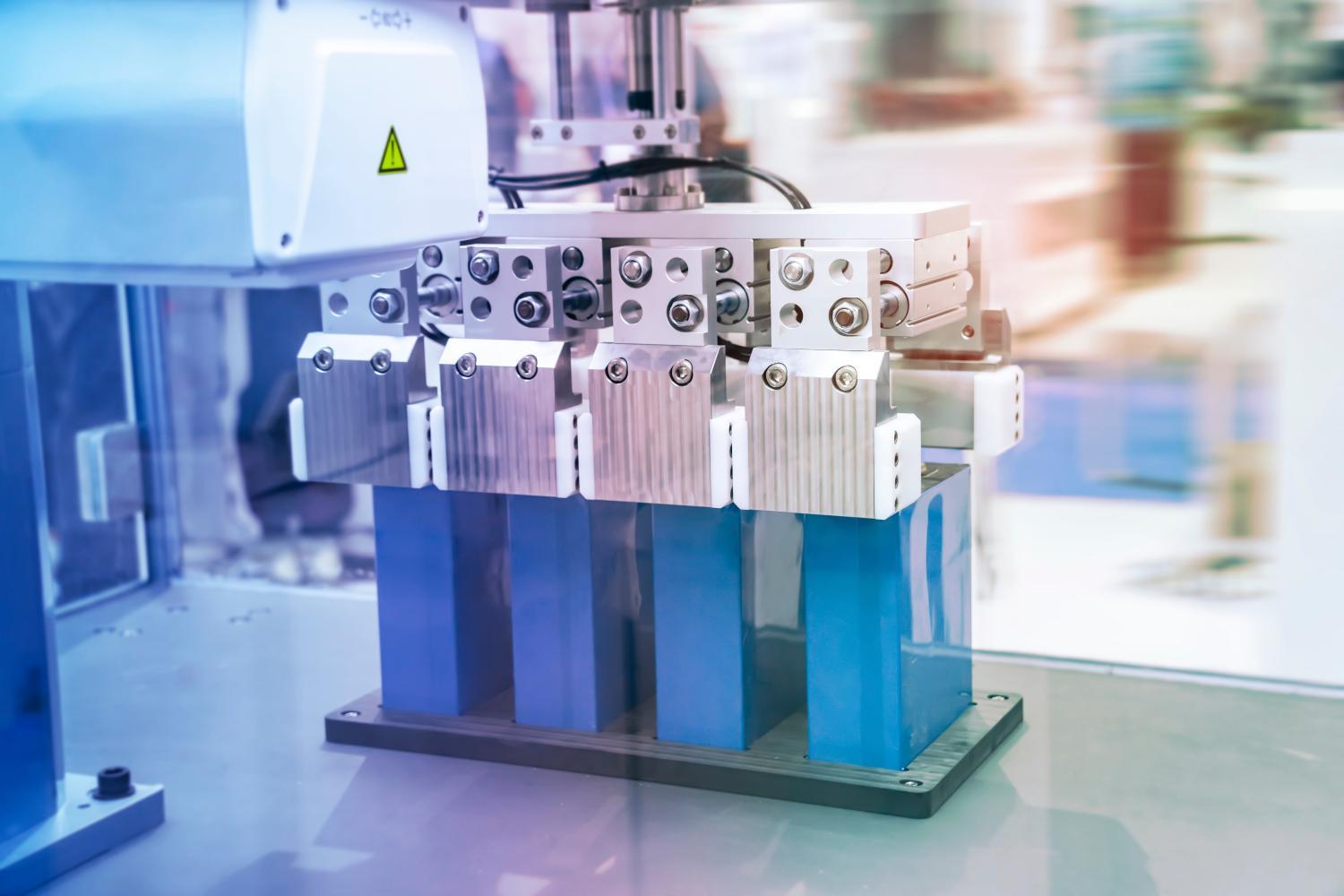
As electric vehicles and renewable energy storage become central to the global energy transition, the battery supply chain is under more pressure than ever. In 2024, global battery demand surpassed 1 terawatt-hour, equal to powering 100 million homes for an hour, according to the International Energy Agency. But while demand is booming, the infrastructure to meet it — especially in the U.S. — is still catching up.
The U.S. Push for Battery Independence
For years, the U.S. has relied heavily on foreign sources for battery components and materials. Now, with geopolitical tensions rising and clean energy goals looming, policymakers are trying to change that. The Inflation Reduction Act (IRA), passed in 2022, offered tax credits and incentives to boost domestic battery production. It also introduced restrictions to limit reliance on adversarial nations.
“These policies, as well as support from state and local governments, have significantly accelerated battery manufacturing in the U.S.,” said Matt McDowell, a mechanical engineering and materials science professor at Georgia Tech and Carter N. Paden Jr. Distinguished Chair for Innovation in Material Science and Metals Processing. “But we’re still in the early stages of building a truly resilient supply chain.”
Gleb Yushin, a professor at Georgia Tech and chief technical officer of battery materials company Sila, agrees. “The IRA’s FEOC restrictions sent a timely, much-needed market signal to spur demand for battery materials made outside of China and, in turn, investments by cell makers into local suppliers,” he said.
Still, reshoring production is no small feat. “It’s been great to see increased domestic production of graphite and other components,” McDowell added. “This will result in more robust battery supply and lower prices in the long-term.”
How New Materials Are Changing the Game
While policy is one piece of the puzzle, innovation is another. For decades, graphite has been the go-to material for battery anodes. But researchers have long eyed silicon as a more powerful alternative — one that can store up to 10 times more charge.
The problem? Silicon swells dramatically during charging, which can damage the battery. “It expands by 300%,” Yushin explained. “That’s compared to just 7% for graphite.”
After years of research, Sila developed Titan Silicon™, a silicon-carbon composite that solves the swelling issue. “It offers 25–35% more energy density, over two times faster charging, and can be dropped into any production line,” Yushin said. “Now, the challenge lies in scaling this technology for mass production while staying ahead of market pressures.”
Solid-state and lithium-sulfur batteries are also gaining attention for their potential to improve safety and performance. But while McDowell is excited about these technologies, he cautions that they’re not yet ready for prime time. “A key focus is developing scalable manufacturing processes to compete with lithium-ion batteries,” he said.
Yushin is more skeptical of the benefits. “Solid-state batteries require entirely new supply chains and infrastructure,” he said. “Silicon is a perfect replacement for lithium metal — it’s stable, reversible, and compatible with existing infrastructure.”
What It Will Take to Compete and Lead
The IRA initially generated over $115 billion in clean energy investments, with $69 billion directed toward battery manufacturing. But with parts of the law now under threat of repeal, the future is uncertain.
“Now that most of the IRA stands to be repealed, we will see if a tariff approach can spur the same results,” Yushin said. “There’s a lot of capital waiting on the sidelines. But without long-term certainty, it’s hard to justify the risk.”
He also pointed to deeper structural issues. “Capital intensity and the cost of borrowing are primary inhibitors of investment,” he said. “Firm purchasing of goods is required to secure financing, but uncertainty over tax credits has cooled demand for local supply.”
McDowell believes the solution lies in a broader strategy. “We need to invest in workforce development, research, and infrastructure,” he said. “This isn’t just about batteries — it’s about building an entire ecosystem.”
Siobhan Rodriguez
Senior Media Relations Representative
Institute Communications
Volcano “Hidden in Plain Sight” Could Help Date Mars — and Its Habitability
Jun 05, 2025 —

A view of Jezero Mons from the publication. The mountain is ~21 km across.
Georgia Tech scientists have uncovered evidence that a mountain on the rim of Jezero Crater — where NASA’s Perseverance Rover is currently collecting samples for possible return to Earth — is likely a volcano. Called Jezero Mons, it is nearly half the size of the crater itself and could add critical clues to the habitability and volcanism of Mars, transforming how we understand Mars’ geologic history.
The study, “Evidence for a composite volcano on the rim of Jezero crater on Mars,” was published this May in the Nature-family journal Communications Earth & Environment, and underscores how much we have left to learn about one of the most well-studied regions of Mars.
Lead author Sara C. Cuevas-Quiñones completed the research as an undergraduate during a summer program at Georgia Tech; she is now a graduate student at Brown University. The team also included corresponding author Professor James J. Wray (School of Earth and Atmospheric Sciences), Assistant Professor Frances Rivera-Hernández (School of Earth and Atmospheric Sciences), and Jacob Adler, then a postdoctoral fellow at Georgia Tech and now an assistant research professor at Arizona State University.
“Volcanism on Mars is intriguing for a number of reasons — from the implications it has on habitability, to better constraining the geologic history,” Wray says. “Jezero Crater is one of the best studied sites on Mars. If we are just now identifying a volcano here, imagine how many more could be on Mars. Volcanoes may be even more widespread across Mars than we thought.”
A mountain in the margins
Wray first noticed the mountain in 2007, while considering Jezero Crater as a graduate student.
“I was looking at low-resolution photos of the area and noticed a mountain on the crater’s rim,” he recalls. “To me, it looked like a volcano, but it was difficult to get additional images.” At the time, Jezero Crater was newly discovered, and imaging focused almost entirely on its intriguing water history, which is on the opposite side of the 28-mile-wide crater.
Then, Jezero Crater, due to these lake-like sedimentary deposits, was selected as the landing spot for the 2020 Perseverance Rover — an ongoing NASA mission seeking signs of ancient Martian life and collecting rock samples for possible return to Earth.
However, after landing, some of the first rocks Perseverance encountered were not the sedimentary deposits one might expect from a previously-flooded area — they were volcanic. Wray suspected he might know the origin of these rocks, but to make a case for it, he would need to show that the mountain on the edge of Jezero Crater could indeed be a volcano.
A new researcher — and old data
The opportunity presented itself several months after Perseverance landed when Cuevas-Quiñones applied to a Summer Research Experience for Undergraduates (REU) program hosted by the School of Earth and Atmospheric Sciences to work with Wray.
“A previous study led by Briony Horgan (professor of planetary science at Purdue University) had also suggested that Jezero Mons could be volcanic,” Cuevas-Quiñones says. “I began wondering if there was a way to home in on these suspicions.”
The team partnered with study coauthor Rivera-Hernández, who specializes in characterizing the surface of planets and their habitability. They decided to use datasets gathered from spacecraft orbiting Mars to compare the properties of Jezero Mons to other, known, volcanoes. “We can’t visit Mars and definitively prove that Jezero Mons is a volcano, but we can show that it shares the same properties with existing volcanoes — both here on Earth and Mars,” Wray explains.
“We used data from the Mars Odyssey Orbiter, Mars Reconnaissance Orbiter, ExoMars Trace Gas Orbiter, and Perseverance Rover, all in combination to puzzle this out,” he adds. “I think this shows that these older spacecraft can be extremely valuable long after their initial missions end — these old spacecraft can still make important discoveries and help us answer tricky questions.”
For Cuevas-Quiñones, it also underscores the importance of REU programs and opportunities for undergraduates. “I was an undergraduate student at the time, and this was my first time conducting research,” she says. “It was fascinating to learn how different data sets could be used to decode the origin of a landscape. After Jezero Mons, it became clear to me that I would continue to study Mars and other planetary bodies.”
The search for life — and determining Mars’ age
The discovery makes the crater even more intriguing in the search for past life on Mars. A volcano so close to watery Jezero Crater could add a critical source of heat on an otherwise cold planet, including the potential for hydrothermal activity — energy that life could use to thrive.
This type of system also holds interest for Mars as a whole. “The coalescence of these two types of systems makes Jezero more interesting than ever,” shares Wray. “We have samples of incredible sedimentary rocks that could be from a habitable region alongside igneous rocks with important scientific value.” If returned to Earth, igneous rocks can be radioisotope dated to know their age very precisely. Dating the Jezero Crater samples could be used to calibrate age estimates, providing an unprecedented window into the geologic history of the planet.
The take home message? “Mars is the best place we have to look in our solar system for signs of life, and thanks to the Perseverance Rover collecting samples in Jezero, the United States has samples from the best rocks in the best place on Mars,” Wray says. “If these samples are returned to Earth, we can do incredible, groundbreaking science with them.”
DOI: https://doi.org/10.1038/s43247-025-02329-7
Funding: Cuevas-Quiñones was supported by Georgia Tech’s 2021 Research Experience for Undergraduates program sponsored by 3M corporation. Wray was supported by NASA funding for Co-Investigators on HiRISE and CaSSIS. CaSSIS is a project of the University of Bern and funded through the Swiss Space Office via ESA’s PRODEX program. The instrument hardware development was also supported by the Italian Space Agency (ASI) (ASI-INAF agreement 2020-17-HH.0), INAF/Astronomical Observatory of Padova, and the Space Research Center (CBK) in Warsaw. Support from SGF (Budapest), the University of Arizona Lunar and Planetary Lab, and NASA are also gratefully acknowledged. Operation support from the UK Space Agency is also acknowledged.
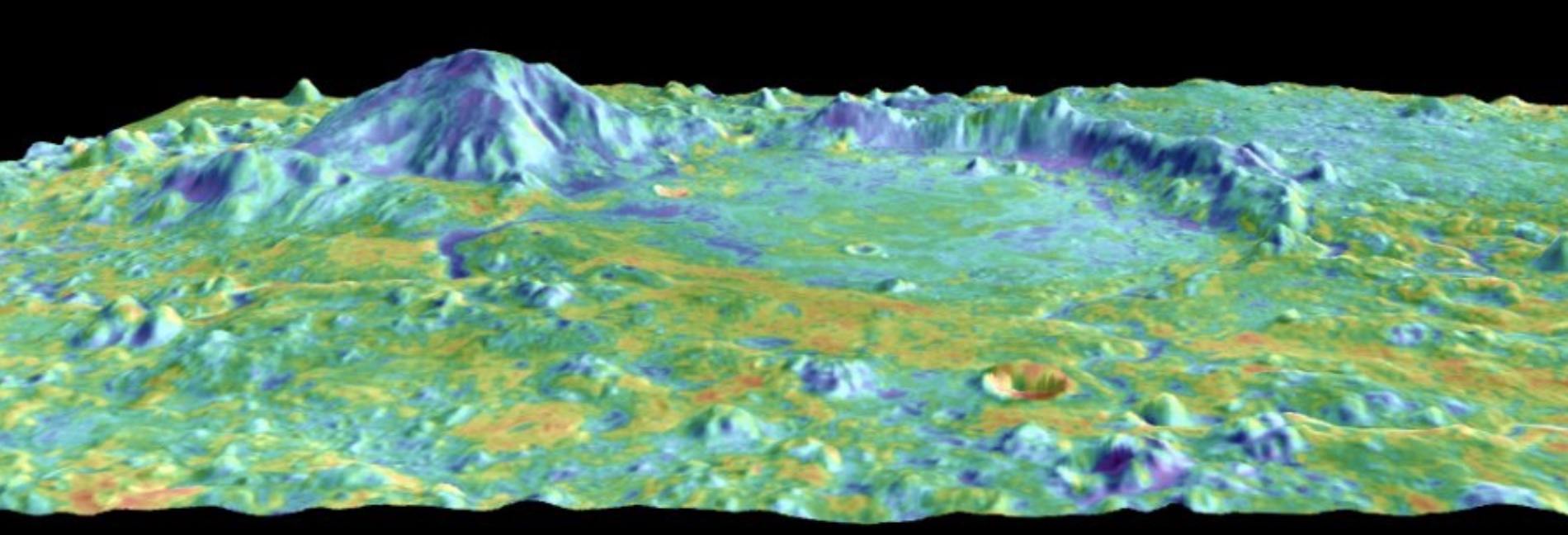
An image from the publication showing an oblique view from north-northeast of Jezero crater, with topography exaggerated ~3x
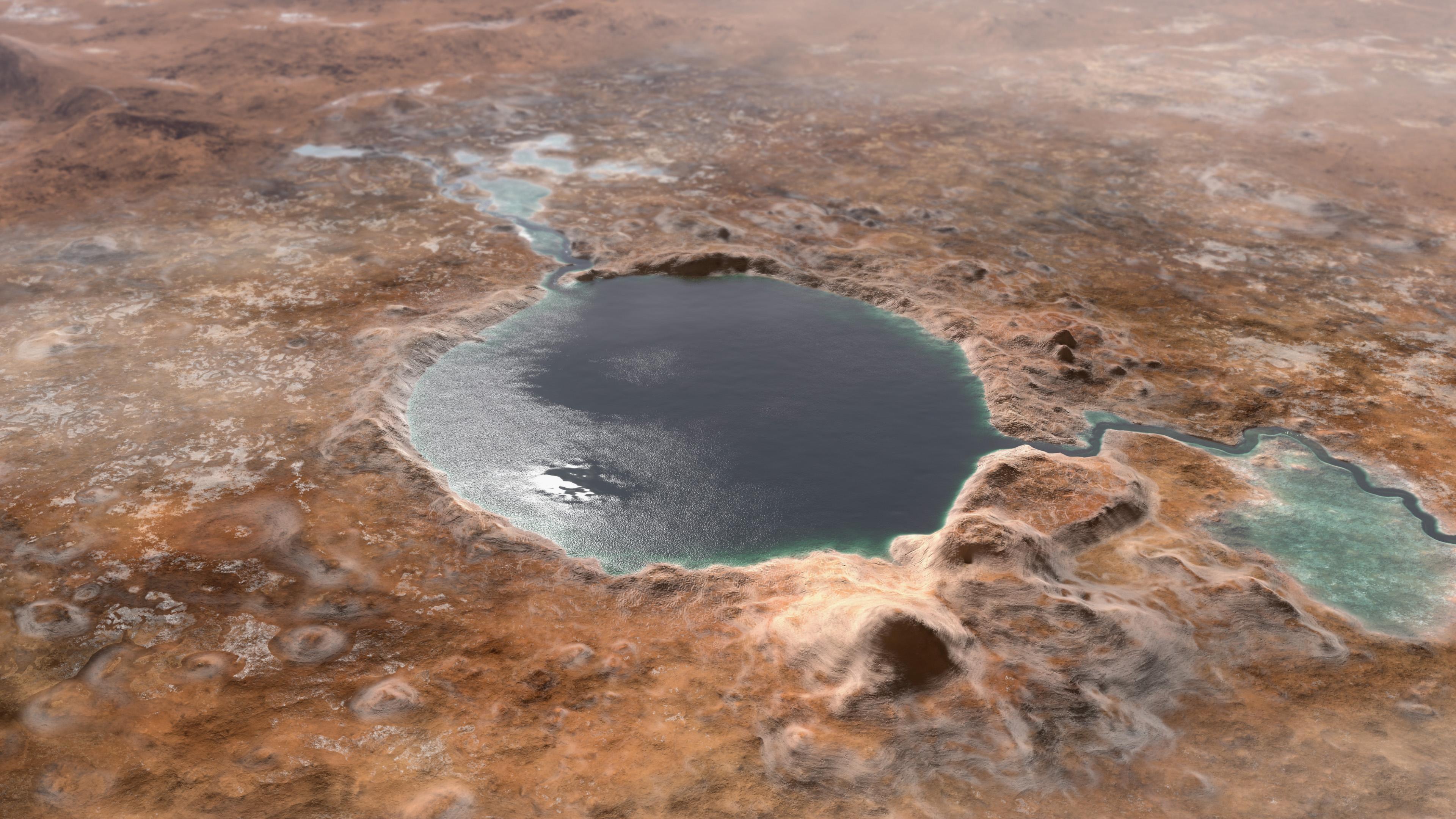
An illustration of Jezero Crater as it may have looked billions of years go on Mars, when it was a lake. Jezero Mons is visible on the front right-side of the crater rim. (Credit: NASA)
Written by Selena Langner
Designing the Future of Teamwork: Human-AI Collaboration Takes Center Stage in New Competition
Jun 04, 2025 — Atlanta, GA

Pictured: Interactive Computing Ph.D. students Glen Smith (left) and Qiao Zhang (right) working with Assistant Professor Christopher MacLellan (middle) on the Dice Adventure game.
In a world rapidly embracing artificial intelligence, researchers are turning their attention to a critical question: How can AI agents become not just tools, but true teammates? Christopher MacLellan, assistant professor in the School of Interactive Computing and faculty member of the Institute for People and Technology, and his team are tackling this challenge head-on through a groundbreaking initiative that blends research, competition, and collaboration.
At the heart of their work is a unique human-AI teaming tournament competition — believed to be the first of its kind — designed to explore how people and AI agents can work together effectively. Unlike traditional AI competitions that pit agents against one another, this event emphasizes cooperation. Participants design AI agents that can collaborate with humans or other agents to achieve shared goals in a team tournament setting.
“We’re interested in using cooperative games as a tool to understand how people and agents can team together more effectively,” MacLellan explains. “This competition is a step toward designing AI that doesn’t just follow commands, but anticipates needs and acts as a true partner.”
The competition, now in its second year and hosted in conjunction with the IEEE Conference on Games, invites participants to submit their own AI agents or join as human players teaming up with others’ agents. With up to $1,000 in cash prizes sponsored by IEEE, the August event offers both a fun and meaningful way to contribute to the future of AI development.
The team’s research paper about the game, Dice Adventure: An Asymmetrical Collaborative Game for Exploring the Hybrid Teaming Effects, won the best paper award at this year’s International Conference on the Foundations of Digital Games. Georgia Tech Interactive Computing Ph.D. students Qiao Zhang, organized the competition and was the lead author of the paper, along with Glen Smith, co-author.
More than just a contest, the initiative reflects a broader vision. As MacLellan puts it, “Society is moving toward a future where humans and agents work seamlessly together. We want to design for the best possible futures — where AI agents know how to team back with people.”
This vision challenges the conventional view of AI as mere tools. Instead, it promotes a paradigm where agents are proactive collaborators — anticipating needs, adapting to human behavior, and contributing meaningfully to shared objectives.
For those interested in participating in the upcoming tournament competition or learning more, details including dates and registration information are available on the competition’s official webpage: https://strong-tact.github.io. The competition is taking place online during June and July and the results will be presented at the IEEE 2025 Conference on Games, Aug 26-29.
As AI continues to evolve, efforts like this competition are paving the way for a future where humans and machines don’t just coexist — they thrive together as teammates.
About the Research
This research was supported by the Army Research Lab STRONG program awards W911NF2120126, W911NF2120101, W911NF2320203.
Citation: Zhang, Q., Smith, G., Ziyu, L., Dong, Y., Harpstead, E. & MacLellan, C.J. (2025). Dice Adventure: An Asymmetrical Collaborative Game for Exploring the Hybrid Teaming Effects. In Proceedings of the 19th International Conference on the Foundations of Digital Games. https://doi.org/10.1145/3723498.3723793.

